Have you ever wondered where to find the perfect tropical paradise? Look no further than Boracay Island, located in the stunning Western Visayas region of the Philippines. With its crystal-clear waters and pristine white sand beaches, this island destination is a true gem waiting to be explored.
Boracay Island is situated just 0.8 kilometers off the northwest coast of Panay, making it easily accessible for travelers seeking a slice of heaven. Spanning a total land area of 10.32 square kilometers, the island is under the jurisdiction of three barangays in Malay, Aklan. Its favorable location and stunning natural beauty have made it a popular destination for tourists from around the world.
Renowned for its picture-perfect beaches, Boracay Island offers an idyllic escape from the hustle and bustle of everyday life. Whether you’re looking for a romantic getaway, an adventure-filled vacation, or simply a place to relax and unwind, this island has it all.
Key Takeaways:
- Boracay Island is a resort island in the Western Visayas region of the Philippines, located 0.8 kilometers off the northwest coast of Panay.
- The island has a total land area of 10.32 square kilometers and is under the jurisdiction of three barangays in Malay, Aklan.
- Boracay Island is famous for its white sand beaches and crystal-clear waters, attracting visitors from all over the world.
- Whether you’re seeking relaxation, adventure, or a romantic getaway, Boracay Island offers something for everyone.
- Discover the beauty of this tropical paradise and experience all that Boracay Island has to offer.
Geography of Boracay Island
Boracay Island, situated in Aklan province on Panay Island, is a tropical paradise renowned for its stunning natural beauty. Located 0.8 kilometers off the northwest corner of the mainland, this idyllic island spans an area of 10.32 square kilometers. With its seven-kilometer length, Boracay Island is shaped like a barbell, offering diverse landscapes and breathtaking vistas to explore.
When it comes to beaches, Boracay Island doesn’t disappoint. Its main attractions, White Beach and Bulabog Beach, are found on opposite sides of the island, offering distinct experiences. White Beach faces westward, allowing visitors to witness awe-inspiring sunsets over the horizon, while Bulabog Beach faces eastward, welcoming early-morning adventurers seeking exhilarating water sports and wind adventures.
Immerse yourself in the beauty of Boracay Island by indulging in leisurely strolls along the powdery white sand beaches, witnessing breathtaking panoramic views from viewpoints like Mount Luho, or simply basking in the warm tropical sun. No matter where your wanderings take you, Boracay Island’s geography promises an unforgettable experience for every traveler.
History of Boracay Island
Boracay Island has a fascinating history that dates back centuries. It was originally inhabited by the Tumandok and Ati people, indigenous tribes who lived off the land and sea. The island’s pristine beaches and abundant natural resources made it an ideal home for these communities.
In the 1970s, Boracay started to attract the attention of commercial developers and adventurous travelers. The island’s allure, with its crystal-clear waters and powdery white sand, began to draw tourists from around the world. As tourism grew, so did the need for accommodations, leading to the development of hotels and resorts.
“Boracay Island has become synonymous with luxury and relaxation, offering a wide range of high-end resorts and hotels. One of the most renowned properties is the Shangri-La resort & spa, which provides guests with a luxurious retreat amidst the island’s natural beauty.”
However, the rapid increase in tourism also brought about sustainability issues and environmental concerns. The surge in visitors took a toll on the island’s delicate ecosystem, leading to pollution and degradation of the surrounding waters and coral reefs.
In 2018, the government made the bold decision to close Boracay Island for six months to address these pressing issues. This closure allowed for major renovation and redevelopment works, with a focus on upgrading the island’s infrastructure, including the sewage system and waste management facilities.
The closure served as a wake-up call for the island’s stakeholders, highlighting the importance of sustainable tourism practices. Since its reopening, Boracay Island has implemented stricter regulations and guidelines to ensure the preservation of its natural beauty and the long-term sustainability of its tourism industry.
Today, Boracay Island continues to be a sought-after destination for those seeking a tropical paradise experience. With its rich history, breathtaking beaches, and ongoing efforts to promote sustainability, Boracay offers a unique blend of luxury and environmental consciousness.
Tourism in Boracay Island
Boracay Island has become a renowned destination for travelers looking for a perfect blend of relaxation and adventure. With its breathtaking white sand beaches, crystal-clear waters, and vibrant nightlife, it captivates visitors from around the world. Whether you’re seeking thrilling activities or simply want to unwind under the sun, Boracay offers an array of options that cater to every taste.
One of the highlights of Boracay Island is its diverse range of activities. Adventure enthusiasts can indulge in exciting water sports such as jet skiing, parasailing, and paddleboarding. Exploring the stunning marine life through snorkeling and scuba diving is a must for nature lovers. Take a boat tour around the island and discover hidden gems, secluded coves, and pristine dive sites. The possibilities are endless.
On land, you can take leisurely strolls along the beach and immerse yourself in the vibrant atmosphere. Enjoy a relaxing massage by the shore or participate in beach yoga classes to rejuvenate your mind and body. For those who love shopping and culinary delights, Boracay’s beachfront offers an abundance of boutique shops, local handicrafts, and restaurants serving delicious international and local cuisines.
Island Hopping and Dreamlike Beaches
One of the absolute highlights of Boracay Island is the opportunity to go island hopping. Hop on a boat and discover neighboring islands like Crystal Cove, Crocodile Island, and Puka Shell Beach. Marvel at the stunning rock formations, swim in crystal-clear waters, and enjoy picnics on secluded beaches.
The crowning jewel of Boracay Island is its alluring White Beach. Extending over four kilometers, this pristine stretch of powdery white sand offers a serene ambiance and breathtaking sunsets. It has been named one of the best beaches in the world, drawing travelers seeking tranquility and natural beauty.
“Boracay Island is a paradise on earth, the perfect destination for beach lovers, water sports enthusiasts, and those in search of relaxation. Its beauty is unmatched, and the opportunities for adventure are endless.”
Plan Your Perfect Getaway
To make the most of your time on Boracay Island, it’s recommended to follow a travel guide. These guides provide valuable insights into the best accommodations, recommended restaurants, and must-visit attractions. With their expertise, you can craft an itinerary tailored to your preferences, ensuring you don’t miss out on any of the island’s wonders.
| Activities | Water Sports | Island Hopping | Snorkeling and Scuba Diving |
|---|---|---|---|
| Availability | Throughout the year | Recommended during dry season (November to May) | Year-round, with best visibility from December to April |
| Highlights | Jet skiing, parasailing, paddleboarding | Crystal Cove, Crocodile Island, Puka Shell Beach | Breathtaking coral reefs, vibrant marine life |
Visiting Boracay Island guarantees an unforgettable experience. From thrilling water sports to picturesque beaches and a vibrant nightlife, the island has something for everyone. Immerse yourself in its beauty, indulge in exciting activities, and create memories that will last a lifetime. Start planning your dream vacation to Boracay Island, and let its enchanting charm captivate you.
Recognition and Awards for Boracay Island
Boracay Island has garnered numerous awards and prestigious recognition for its breathtaking beauty and unparalleled charm. Its allure has captivated travelers from around the globe, making it a renowned destination beloved by many. The island stands as a testament to nature’s splendor, attracting both leisure seekers and adventure enthusiasts alike.
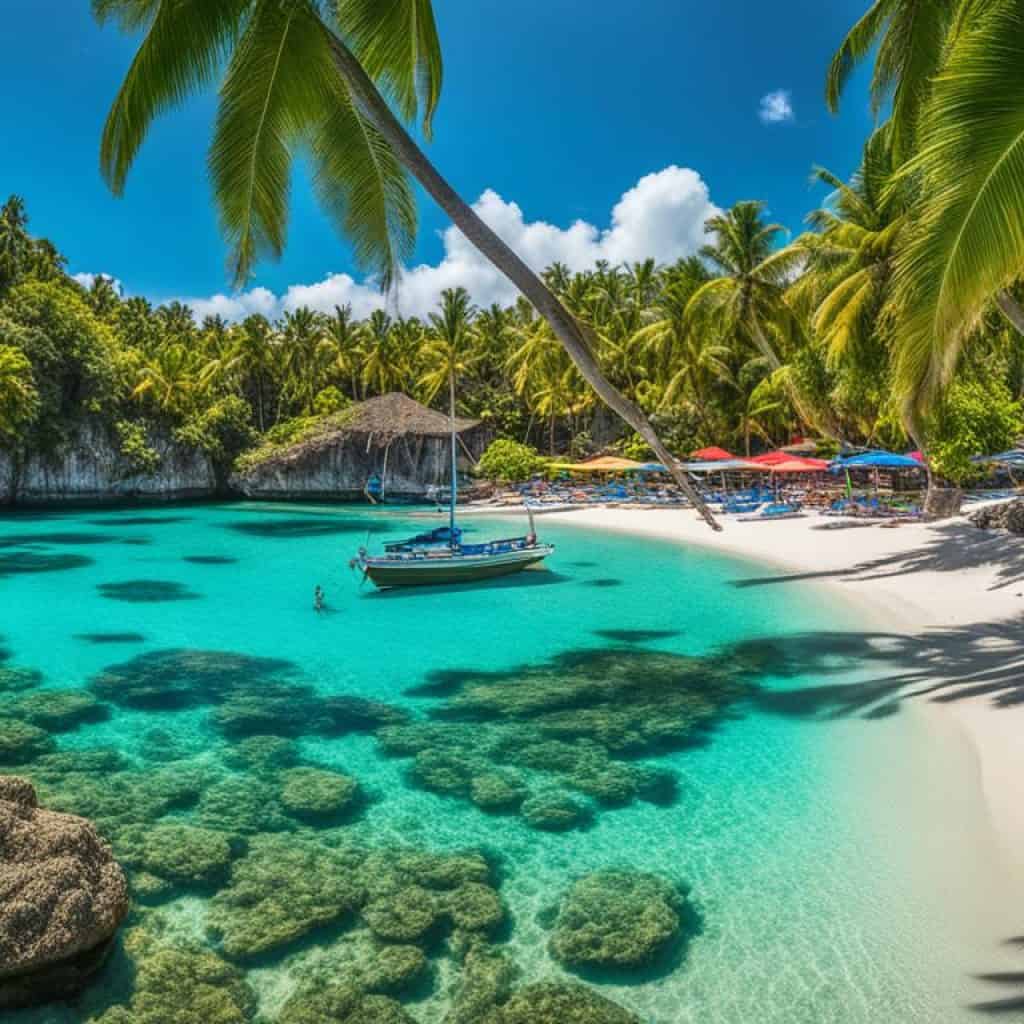
Award-Winning Paradise
The accolades bestowed upon Boracay Island are a true testament to its magnificence. In 2012, the renowned Travel + Leisure magazine honored Boracay as the Best Island in the World, showcasing its unparalleled natural beauty and pristine beaches. This prestigious recognition solidified Boracay’s status as a must-visit tropical paradise.
“The Best Island in the World award goes to Boracay, a small island in the Philippines that boasts stunning white sand beaches, crystal-clear waters, and vibrant marine life. It’s no wonder why travelers from all over the world flock to this enchanting destination.”
Condé Nast Traveler, a trusted name in the travel industry, also recognized Boracay’s captivating allure. In 2014, the magazine listed Boracay as one of the Best Islands in the World, further cementing its position as a top-notch travel destination.
“Boracay Island, with its powdery white sand beaches and turquoise waters, has earned its spot amongst the world’s best islands. Visitors are drawn to its idyllic beauty, warm hospitality, and a plethora of activities that cater to all types of travelers.”
Boracay has consistently been featured on various prestigious lists of top travel destinations. The island’s harmonious blend of natural wonders, vibrant culture, and warm hospitality has captured the hearts of many wanderlusts seeking a tropical escape.
Award-Winning Paradise
| Award | Year | Publication/Organization |
|---|---|---|
| Best Island in the World | 2012 | Travel + Leisure magazine |
| Best Islands in the World | 2014 | Condé Nast Traveler |
| Top Travel Destinations | Multiple years | Various publications |
These prestigious awards and accolades perfectly reflect the popularity and enduring appeal of Boracay Island. Its pristine beaches, crystal-clear waters, and vibrant atmosphere continue to charm and captivate travelers from across the globe.
Closure and Rehabilitation of Boracay Island
In 2018, the Philippine government made the difficult decision to order a six-month closure of Boracay Island, a popular tourist destination, in order to address pressing issues and undertake major renovation works. The primary focus of the closure was the island’s sewage system, which had become outdated and insufficient to handle the increasing demands of tourism. The closure was aimed at ensuring the long-term sustainability and preservation of Boracay Island’s natural beauty.
The closure of Boracay Island was carried out under the administration of the Boracay Inter-agency Task Force. During this period, strict measures were implemented to facilitate the necessary improvements. This included the establishment of new rules and regulations to address issues such as waste management, zoning, and environmental protection.
After six months of intense renovation and rehabilitation efforts, Boracay Island reopened to the public in October 2018. The reopening marked a significant milestone in the journey towards restoring the island’s pristine condition and enhancing its sustainability. Visitors to the island are now greeted with a renewed sense of commitment to responsible tourism and the preservation of its natural resources.
The rehabilitation of Boracay Island is an ongoing process, with ongoing efforts to ensure that the beaches remain in excellent condition and that sustainable practices are implemented. The Philippine government, in partnership with various stakeholders, continues to work towards striking the delicate balance between tourism development and environmental preservation.
“The closure and rehabilitation of Boracay Island underscore the government’s commitment to protect not only the natural beauty of the island but also the livelihoods of the local community. It serves as a model for sustainable tourism practices and sets the stage for other destinations to follow suit.” – Environmental Secretary Roy Cimatu
By implementing stricter regulations, promoting responsible tourism, and investing in infrastructure upgrades, Boracay Island aims to preserve its status as a world-class travel destination while safeguarding the rich biodiversity and cultural heritage of the region.
Key Points:
- The closure of Boracay Island in 2018 aimed to address issues with the outdated sewage system.
- The closure lasted for six months and was administered by the Boracay Inter-agency Task Force.
- The island reopened to the public in October 2018 with new rules and regulations.
- Ongoing rehabilitation efforts focus on maintaining pristine beaches and implementing sustainable practices.
- The closure of Boracay Island serves as a model for other destinations in terms of sustainable tourism practices.
Boracay Island’s Indigenous People
The cultural heritage of Boracay Island is deeply intertwined with the indigenous Ati people who have a long history on the island. However, the rapid commercial development of the area has resulted in the marginalization and displacement of the Ati people, threatening their traditional way of life.
Efforts are now being made to recognize and celebrate the rich cultural heritage of the Ati indigenous people. One of the notable events that showcase their traditions is the Boracay Ati-atihan festival, which attracts a large number of tourists every year.
The Boracay Ati-atihan festival is a vibrant celebration where locals and visitors come together to witness the vibrant street performances, colorful costumes, and rhythmic music. It is a time when the Ati people proudly display their cultural practices and keep their traditions alive.
The festival serves as an avenue to raise awareness of the Ati people’s struggles and their contributions to the island’s history and identity. It is an opportunity for visitors to learn about the indigenous culture, appreciate their artistry, and support initiatives that aim to empower the Ati people.
Boracay Island is striving to strike a balance between tourism development and the preservation of its cultural heritage. It is essential to recognize and respect the rights and interests of the Ati indigenous people, ensuring their participation in decision-making processes that affect their community.
| Challenges Faced by the Ati People | Efforts to Preserve Ati Culture |
|---|---|
| The Ati people have experienced marginalization and displacement due to commercial development. | Initiatives are underway to promote cultural education and awareness, such as workshops and community activities. |
| Loss of traditional lands and resources as a result of land encroachment and development. | Support for sustainable tourism practices that respect the environment and the rights of the Ati people. |
| Challenges in preserving traditional practices and passing them down to future generations. | Collaboration between the Ati community and government agencies to protect ancestral lands and promote cultural preservation. |
The recognition and appreciation of the Ati people’s cultural heritage are crucial in shaping Boracay Island’s sustainable future. By preserving their traditions and empowering the Ati indigenous people, we can ensure that Boracay remains a place where cultural diversity thrives alongside its stunning natural beauty.
The Name and Etymology of Boracay Island
The name Boracay is attributed to different origins. According to the native Ati people, it comes from the Inati words “bora” meaning bubbles and “bocay” meaning white. Another theory suggests that it is derived from the local word “borac,” which means “white cotton,” referring to the color and texture of Boracay’s sand. There is also a version dating back to the Spanish era, which claims that the name is derived from “sagay” meaning shell and “boray” meaning seed.
These various explanations of the name Boracay highlight the island’s cultural and historical significance. The different interpretations add to the charm and mystique of this beloved tropical destination.
Etymology of the Name Boracay Island
| Origin | Meaning |
|---|---|
| Inati Words | “Bora” (bubbles) + “Bocay” (white) |
| Local Word | “Borac” (white cotton) |
| Spanish Era | “Sagay” (shell) + “Boray” (seed) |
The name Boracay encapsulates the island’s natural beauty and captures the imagination of visitors from around the world. Whether you prefer the idea of bubbles and white beaches, the concept of white cotton-like sands, or the symbolism of shells and seeds, the name Boracay adds to the allure of this tropical paradise.
Boracay Island’s Pre-colonial Period
Before the Spanish colonization, Boracay Island was home to the indigenous Ati people. The Ati people lived a simple yet sustainable lifestyle, engaging primarily in rice farming and goat-raising as their main livelihoods. They had a deep connection to the land and practiced traditional agricultural techniques to cultivate their crops.
During this pre-colonial period, the population of Boracay Island was relatively small, with an estimated 100 people inhabiting the island. The Ati people lived in harmony with nature, respecting the resources the island provided and ensuring the well-being of their community.
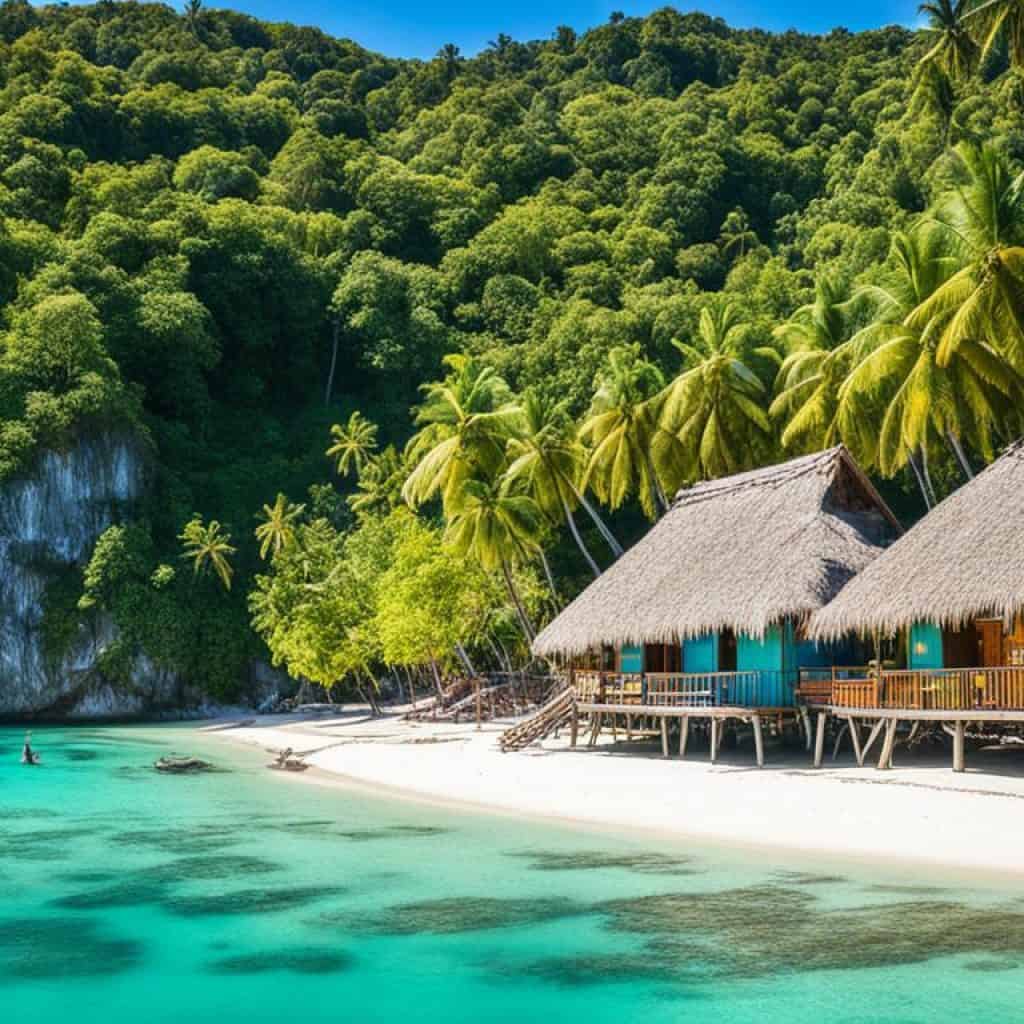
“Our ancestors cherished the bountiful land of Boracay, tending to it with care and gratitude. It was a time of simplicity and sustainability, where we thrived in harmony with nature.” – Ati Elder
Ati Heritage and Cultural Significance
The Ati people have a rich cultural heritage that is deeply rooted in Boracay Island. Their customs, rituals, and traditional practices have been passed down through generations, allowing them to preserve their unique identity and connection to the land.
One of the most significant cultural events celebrated by the Ati people is the Boracay Ati-atihan festival. This vibrant festival showcases their traditional dances, music, and colorful costumes, attracting both locals and tourists alike. The festival is a testament to the Ati people’s resilience and their efforts to reclaim their cultural heritage in the face of modern development.
Preserving Ati Heritage Today
Recognizing the importance of preserving the Ati heritage and supporting the indigenous community, initiatives have been implemented to empower and uplift the Ati people. Collaborations with local organizations and government bodies have been established to promote cultural awareness, provide educational opportunities, and create sustainable economic initiatives.
Through these efforts, the Ati people are given a platform to share their customs and traditions with the world, fostering cultural exchange and understanding. By celebrating and preserving the Ati heritage, Boracay Island embraces its diverse roots and ensures a more inclusive and authentic travel experience for visitors.
| Key Points |
|---|
| The Ati people were the original inhabitants of Boracay Island before the Spanish colonization. |
| Rice farming and goat-raising were the main livelihoods of the Ati people during the pre-colonial period. |
| The Ati people have a rich cultural heritage, celebrated through festivals like the Boracay Ati-atihan. |
| Efforts are being made to preserve and empower the Ati people, ensuring the continuation of their traditions and customs. |
Boracay Island’s Contemporary Period
In the 1940s and 50s, the people of Boracay Island relied on agriculture and fishing as their primary livelihoods. Coconut farming, in particular, played a significant role in the island’s economy. The fertile land and favorable climate made it ideal for cultivating coconuts, which were used for various purposes, including producing copra.
Fishing also served as a major industry in Boracay during this period. The abundant marine resources surrounding the island provided a reliable source of sustenance and income for the local community. Families would venture out to sea to catch fish, which they would then sell or consume.
The island was under the jurisdiction of the town of Buruanga until the establishment of the municipality of Malay in 1949. This administrative change marked a new era for Boracay, fostering local governance and furthering economic development.
However, over the years, the fishing industry began to decline due to overharvesting and environmental degradation. As the population grew and demand increased, unsustainable fishing practices took a toll on the marine ecosystem, leading to a decline in fish stocks.
Additionally, as Boracay’s popularity as a tourist destination started to grow in the 1980s, many locals shifted their focus to the emerging tourism industry. The tranquil beaches and pristine waters attracted visitors from around the world, offering new opportunities for income and economic growth.
Today, Boracay Island continues to evolve as a tourist hotspot, with agriculture and fishing playing a more limited role in the local economy. While there are still pockets of agricultural activities, such as farms cultivating crops like vegetables and fruits, the majority of the island’s focus has shifted towards providing services and amenities to cater to the influx of tourists.
Despite this transformation, it’s important to recognize and appreciate the island’s rich history and connection to its agricultural and fishing roots. The sustainable development and preservation of Boracay’s natural resources remain crucial to ensuring the long-term viability and balance of the island’s economy.
| Industry | Period | Key Highlights |
|---|---|---|
| Agriculture | 1940s-1980s | – Coconut farming (copra production) – Cultivation of crops like vegetables and fruits |
| Fishing | 1940s-1980s | – Decline due to overharvesting and environmental degradation – Transition to tourism as a primary industry |
Boracay Island’s Influx of Tourism
Tourism on Boracay Island started to gain momentum in the 1970s, attracting backpackers in search of affordable getaways. This hidden gem soon became a favorite among travelers seeking a paradise-like destination off the beaten path. The stunning white sand beaches and crystal-clear waters of Boracay Island continuously captivate visitors from around the world, making it a sought-after tropical haven.
The surge in tourist arrivals led to the need for infrastructure development and the establishment of boat stations along White Beach. These initiatives aimed to accommodate the growing influx of visitors and ensure a smooth and enjoyable experience for everyone attracted to Boracay’s unparalleled beauty.
“Boracay Island offers a unique blend of natural wonders and vibrant energy, truly a dream destination for beach lovers and adventure enthusiasts alike.”
Over the years, Boracay Island has evolved into a well-rounded tourist destination. From pristine white sand beaches and thrilling water sports to a lively nightlife scene and delectable dining options, Boracay has something for everyone. Visitors can indulge in activities like snorkeling, scuba diving, island hopping, or simply basking in the sun, savoring the island’s enchanting ambiance.
Whether you’re seeking relaxation, adventure, or a taste of paradise, Boracay Island promises an unforgettable experience. Make sure to explore the diverse attractions and embrace the island’s warm hospitality. Plan your trip to Boracay and embark on an unforgettable journey to one of the world’s most captivating islands.
Recommended Activities on Boracay Island
- Soak up the sun and enjoy the pristine beaches of White Beach and Bulabog Beach.
- Go snorkeling or scuba diving to discover the vibrant marine life.
- Take an island hopping tour to explore the nearby islands and hidden coves.
- Indulge in delicious seafood and local cuisine at the island’s many restaurants.
- Experience the vibrant nightlife with beachfront bars and clubs.
- Try thrilling water sports like parasailing, jet skiing, and paddleboarding.
- Relax with a soothing massage on the beach.
Immerse yourself in the captivating beauty of Boracay Island and create lifelong memories in this tropical paradise.
| Key Highlights of Boracay Island: |
|---|
| Stunning white sand beaches |
| Crystal-clear turquoise waters |
| Vibrant nightlife |
| Thrilling water sports |
| Delicious seafood and local cuisine |
| Lively beachfront bars and clubs |
Boracay Island’s Closure and Redevelopment
Due to growing environmental concerns and sustainability issues, Boracay Island underwent a major closure and redevelopment in 2018. President Rodrigo Duterte mandated the closure for six months to address the island’s sewage and environmental issues. The rehabilitation efforts included upgrading the sewage system, improving water treatment, and implementing sustainable practices. The closure was seen as a necessary step to ensure the long-term preservation and sustainability of Boracay as a tourist destination.
The closure and redevelopment of Boracay Island aimed to restore and protect the natural beauty of the island. By upgrading the sewage system and implementing sustainable practices, the government aimed to address the environmental concerns that had arisen over the years. The closure allowed for comprehensive renovation and redevelopment plans to be put in place. These efforts included proper waste management, restrictions on commercial activities, and the rehabilitation of critical ecosystems.
The redevelopment of Boracay Island also focused on enhancing the tourist experience. The government implemented measures to improve infrastructure, including roads, utilities, and transportation services, to cater to the increasing number of visitors. Additionally, steps were taken to promote responsible tourism and educate tourists on the importance of preserving the island’s natural resources.
“The closure and subsequent redevelopment of Boracay Island demonstrate the commitment of the Philippine government to sustainable tourism and environmental stewardship. It is crucial to strike a balance between promoting tourism and preserving the natural wonders that make Boracay an exceptional destination.”
The closure of Boracay Island was met with mixed reactions from residents, businesses, and tourists. While some acknowledged the importance of the redevelopment efforts for the long-term sustainability of the island and its tourism industry, others were concerned about the economic impact of the closure.
After the six-month closure period, Boracay Island reopened with stricter regulations in place to ensure responsible and sustainable tourism practices. These regulations included limiting the number of daily visitors, enforcing proper waste management, and monitoring activities that could harm the natural environment. The rehabilitation efforts continue to be an ongoing process, with the government and stakeholders working together to preserve the island’s natural beauty and ensure the well-being of its residents and visitors.
The Result of Boracay Island’s Redevelopment
The efforts in redeveloping Boracay Island have yielded positive results. The island’s beaches and water quality have significantly improved, attracting an increasing number of tourists who value sustainable and responsible tourism. Boracay has regained its status as one of the top beach destinations in the Philippines and continues to receive recognition for its beauty and environmental initiatives.
| Year | Award/Recognition |
|---|---|
| 2012 | Best Island in the World – Travel + Leisure magazine |
| 2014 | Best Islands in the World – Condé Nast Traveler |
| 2020 | Top Beach Destination – TripAdvisor |
The redevelopment of Boracay Island serves as a testament to the commitment of the Philippine government and the local community in preserving and promoting sustainable tourism. The ongoing efforts demonstrate the importance of balancing economic growth with environmental conservation, ensuring that future generations can enjoy the beauty of Boracay for years to come.
Conclusion
Boracay Island, with its stunning white sand beaches and crystal-clear waters, remains one of the top travel destinations in the Philippines. Despite the challenges and setbacks it has faced, including the closure and redevelopment, the island continues to attract tourists from around the world. The ongoing efforts to maintain its beauty and sustainability will ensure that Boracay remains a tropical paradise for years to come.
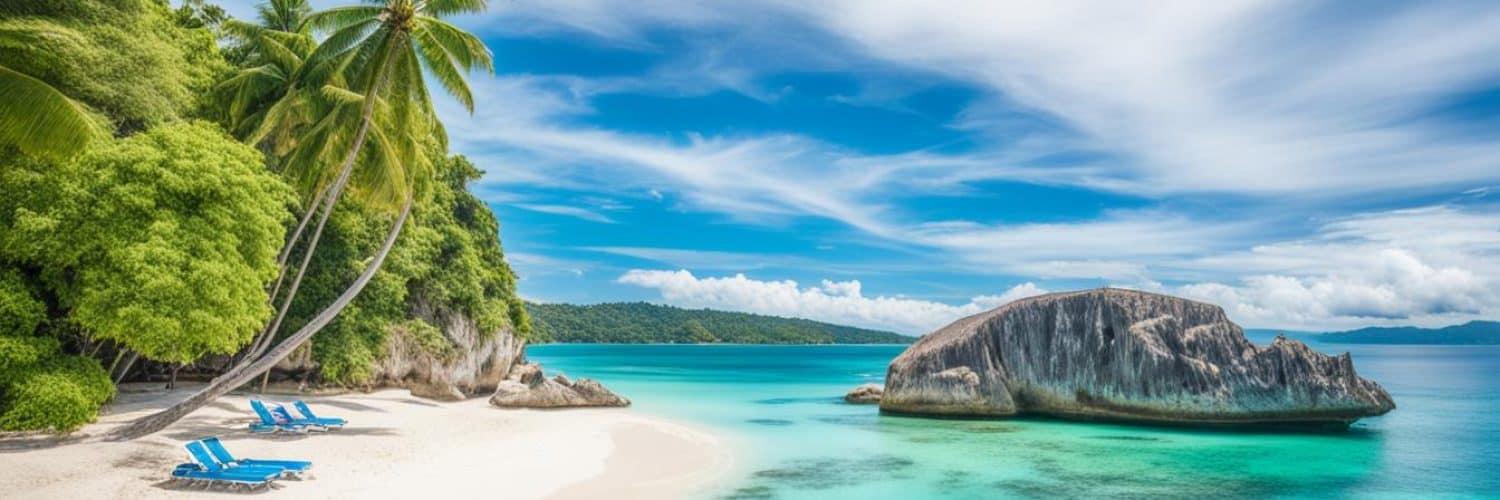

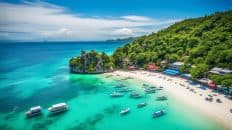
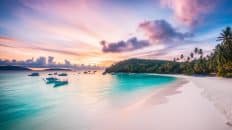














Add comment